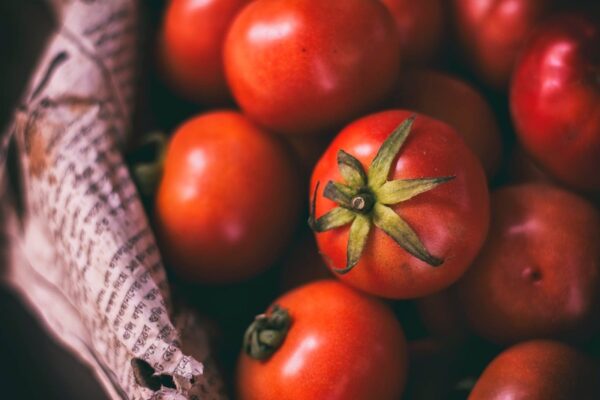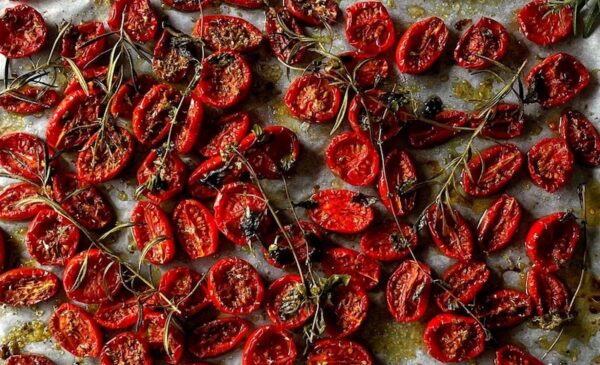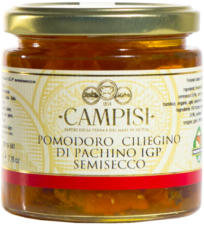We’re back again with the next installment of: Know Your Italian Tomatoes! Today we’ll be discussing everything you need to know about four different Sicilian tomatoes, collectively known as Pachino tomatoes. This includes: where they came from, what to cook with them, and how to get your hands on them.
General Description
Pachino tomatoes are not one, but four different varieties specifically bred to be grown in the town of Pachino in the province of Syracuse in Sicily. They were all bred very recently and are specifically designed to be grown in the excellent climate found in Pachino.

Origin
Until the introduction of the first two pachino varieties in the late eighties, there was very little variation in the tomatoes grown in Sicily. Nearly all you would find in grocery stores were standard, run-of-the-mill salad tomatos. Hazera Genetics, an Israeli seed producer developed the initial two varieties (“Naomi” and “Rita”) which were acquired for exclusive cultivation in the region. These were later followed by two additional varieties (“Lucinda” and “Shiren”) were added to the menu for local farmers to grow. It is unclear exactly who arranged for the acquisition of these new varieties from Hazera. We’re glad they did though, whoever they are, because all of these varieties are fantastic.
Supposedly the local farmers were not initially sold on the new varieties and weren’t keen to grow them. It must have become apparent quickly that the demand for these delicious and beautiful new offerings would be very high. Soon, they dominated local production.
By 2013, all four of the Pachino varieties were granted the PGI (Protected Geographical Indication) label. This means they’re uniquely suited to their environment and can’t be legally sold if they’re not grown in the region. It is likely that this is a legitimate protection – being at the southernmost point in Sicily, Pachino gets more daylight than nearly any other location in Europe, save for some Greek isles and the southernmost part of Spain. All that sunlight, a temperate climate, an ocean breeze, clay soil, slightly brackish water – all combines for an amazing taste.
Pachino Tomato-centered Events
These tomatoes are so delicious and beloved that there are multiple events that celebrate their agricultural pride. The first is named Inverdurata di Pachino, a three day event in May where mosaics are created using local produce, primarily tomatoes. Another is a cherry tomato tradeshow that occurs in July and then again in August. The local version of the Feast of Three Kings (alternately, “the Epiphany”) also prominently includes Pachino tomatoes in the celebratory meals.

Pachino Varieties
Let’s take a closer look at the different tomatoes…
Ciliegino di Pachino – the Cherry tomato
Originally given the codename “Naomi”, the Pachino cherry tomato is slightly smaller than most other varieties of cherries at 12-17mm diameter. They can either grow in tight bunches or as single fruit, and have a very long shelf life. They rank 7-8 on the brix scale, meaning they are a very sweet variety. These were the tomatoes that put Pachino on the agricultural map, and they are so prized they drew imitation. This ultimately lead to the PGI designation.
Tondo Liscio di Pachino – the “Smooth Round” tomato
The Tondo Liscio is aptly named, the medium-sized variety is nearly perfectly circular which is rare for tomatoes larger than a golf ball. They are a very beautiful medium- to dark-green green color. They have a crunchy pulp, which is distinct among the Pachino varieties, and a very distinct taste.
Costoluto di Pachino – the Ribbed tomato
Not the only costoluto tomatoes grown in Italy, the Costoluto Pachino are quite similar to the Costoluto Genovese and Costoluto Fiorentino tomatoes we wrote about previously. They’re very large and slightly flattened in shape, and juicy despite having small gaps for seeds. They tend to have green “collars” and often the color of the entire tomato is a blend of light red and light green. Their optimal harvest season extends into the winter, so they have become the go-to during the winter months, replacing varieties that typically taper off production in the fall.
Grappolo di Pachino – the Grape tomato
Also known as “Snocciolato”, “Grappolo” translates to “bunch” or “cluster” in English, describing the way that they grow. In this regard they are pretty similar to the cherry variety although they are a bit larger. They appear in colors ranging from bright red to dark green, or red with a green collar. They have very dense flesh and amazing taste.
Pachino Nutrition
There isn’t a huge amount of variation in the nutritional profile of different types of tomatoes.
All tomatoes are famous for being high in lycopene – an antioxidant known to have positive effects on aging and inhibit certain types of cancer. Unless you’re on an acid-restricted diet tomatoes are great for you, and Pachinos are definitely included in that list.
All the different Pachino varieties score high on the Brix scale, meaning they are especially sweet.
Pachino recipes
Because there are actually four different types of Pachinos, there is probably no Italian recipe containing tomatoes that at least one Pachino variety would not be appropriate for.
There is a key commonality in the flavor of Pachinos attributable to the growing environment. That makes them somewhat similar to the tomatoes of the Campania region. Specifically, the salinity of the water and the Mediterranean breeze imbues a characteristic flavor. Because of that, these tomatoes very good for seafood recipes. These tomatoes grow within spitting distance of the Mediterranean and it as if the fish know it. If you’re cooking for the feast of the seven fishes, you’d be wise to include Pachinos for at least 1 dish.
Recipe roundup
My first recommendation does not require any recipe… just follow the simple Sicilian preparation of tossing your cherry or grape Pachino tomatoes into a hot pan with garlic, chili pepper, and olive oil. Then, serve up with pasta. You can’t screw it up.
If you’re looking for something more, here are some links to recipes that would be great with Pachino tomatoes…
Any Pachino variety
Cherry or Grappolo
- Spaghettoni with Corbarino Tomatoes, Provolone Fondue, and Basil
- Pasta with Datterini Tomatoes and Crispy Pancetta
- Sea Bass with Sicilian Cherry Tomato Sauce
- Pacheri with Velvety Swordfish
- Mezze Pennone with Seabass, Piennolo Tomatoes, and Gaeta Olives
Tondo Liscio or Costoluto
Pachino Substitutes
Let’s say you see this in a recipe but can’t figure out where to buy them – this is no problem. Honestly, you’re more likely to have the other problem – you have gotten your hands on some delicious Pachino tomatoes and you want to substitute them into a recipe that calls for another type of tomato. In either case, here are a handful of ideal substitutes:
Cherry or Grappolo Pachino Substitutes
- Corbarino – a small variety from Campania that has similar flavor attributes, These are a bit larger than the Cherry and Grappolo Pachinos, are a bit sweeter, and have similar acidity
- Datterini – fairly similar to Grappolos, but with less of the mineral/marine flavor and even more sweetness. These are also smaller, sweeter, and similarly acidic to Pachinos.
- Generic Cherry – It doesn’t matter where you are, you’ll be able to find a variety of cherry tomato in your local grocery store, and they’ll work as a substitute for/by Pachinos. They’re fairly similar in size, acidity, and sweetness to Pachinos, and they’ll likely have a bit more water content.
- Generic Grape – These aren’t a great replacement, but they’ll do in a pinch if you need small tomatoes with low water content. They’re generally fairly bland tomatoes (at least those you’d likely pick up at the grocery store) so I’d only use these as a last resort.
Tondo Liscio or Costoluto Pachino Substitutes
- Costoluto Genovese or Costoluto Fiorentino – very similar Italian beefsteak varieties, these are a bit sweeter than the Costoluto Pachino, but are pretty similar in size, shape, and texture to the Sicilian variety
- Cuore di Bue – another Italian beefsteak variety, this has the lowest acidity of any Italian tomato but is pretty similar in size, shape, and texture to the the larger Pachino varieties
- Pantano – a large, fleshy tomato with low acid, very few seeds, and an incredible taste. The tops may stay green even when fully ripe, so there’d be a bit of an interesting color.
General Pachino Substitutes
- San Marzano – if the size of the tomato isn’t relevant (soups and sauces definitely fill the bill) then San Marzanos make a great replacement for pretty much anything. They have a strong, delicious flavor just like Pachinos, and you can’t go wrong
Where to Buy Pachino Tomatoes
Fresh
Since these are PGI tomatoes, you technically shouldn’t be able to find these for sale outside Sicily unless they took a trip on a boat or plane. Additionally, they’ve been bred to be hybrid seeds, meaning even if an enterprising farmer saved seeds from a tomato they got their hands on, they wouldn’t be able to grow Pachinos, they’d get one of the parent plants that the Pachino was bred from. To be clear, these are NOT heirlooms!
It’s fairly likely that you’re just not going to be able to find them fresh unless you live within a reasonable distance from Italy for produce to travel. I would typically recommend that you grow your own, but the seeds are not sold to anyone outside approved farmers in Pachino. So… you’re going to be stuck with canned!
UPDATE: I found a website named Only Italian Products where you can buy fresh Cherry Pachino tomatoes online for worldwide delivery! Shipping 1kg of tomatoes to my home in the US costs a paltry……… €49.80!

Canned and Jarred
I searched high and low but I had no luck at any of my local Italian delis, you may have better luck. Fortunately, there are a handful of online sellers of these tomatoes:
- Coluccio – Cherry Tomatoes in Puree(Amazon)
- Only Italian Products – Pachino Tomato Sauce
- Campisi – Cherry Pachinos, Semi-dry in oil
- Contino Semi-dried Pachinos
- Campisi – Bag of Dried Pachinos
- Campisi – Pescatora Sauce
How to grow Piennolo tomatoes
Bad news… you’re not going to be able to grow these, unless you have a connection to the seed company that bred them. I’ve seen people selling “Pachino” seeds online, but they’re not going to be the same thing as what’s growing in Sicily. Likely they’re real seeds from real Pachino tomatoes, but as hybrids, what grows from those seeds will be one of the varieties used to cross-breed the strain, not the strain itself.
Feel free to give them a shot, but they’re not the real deal.


